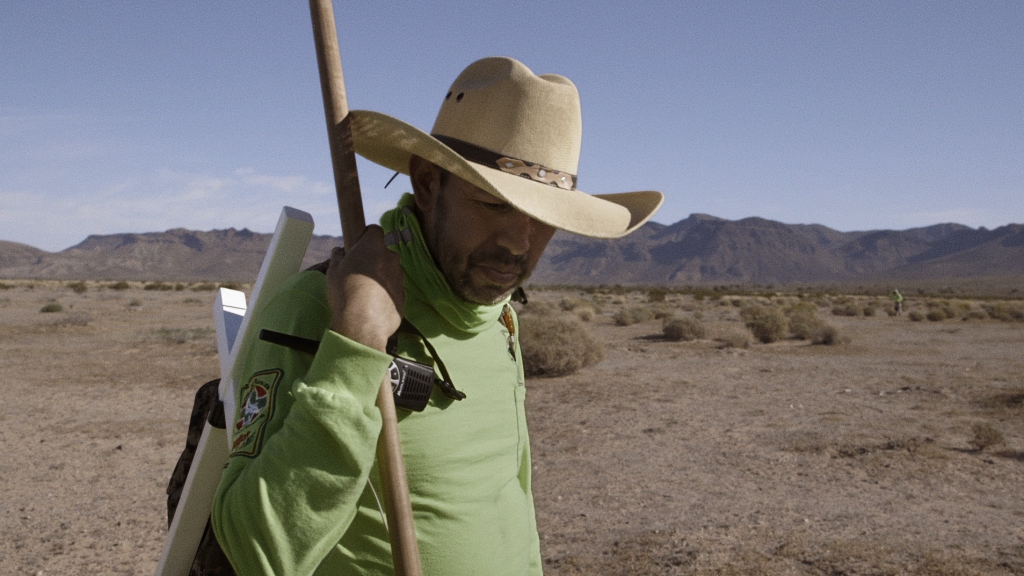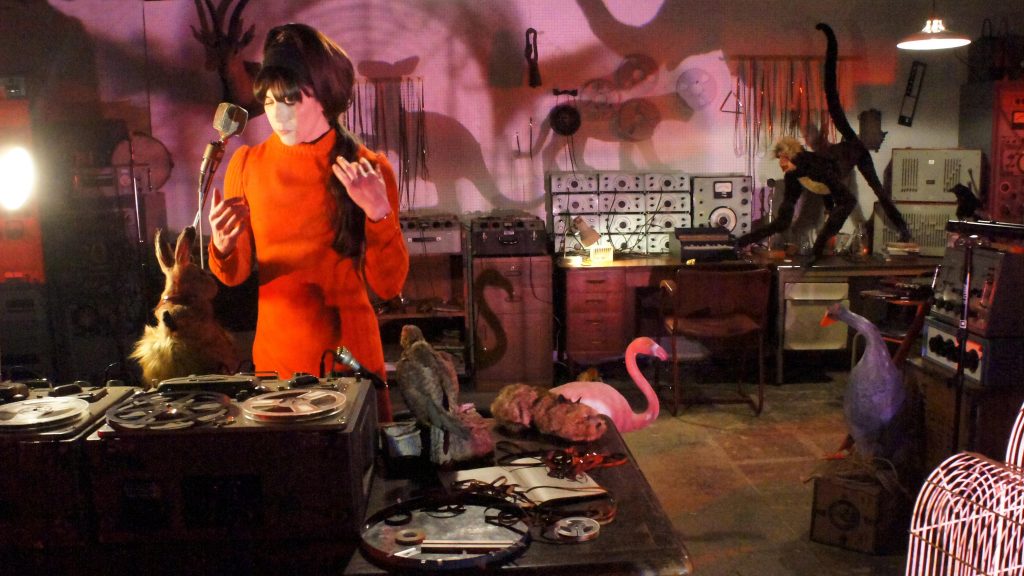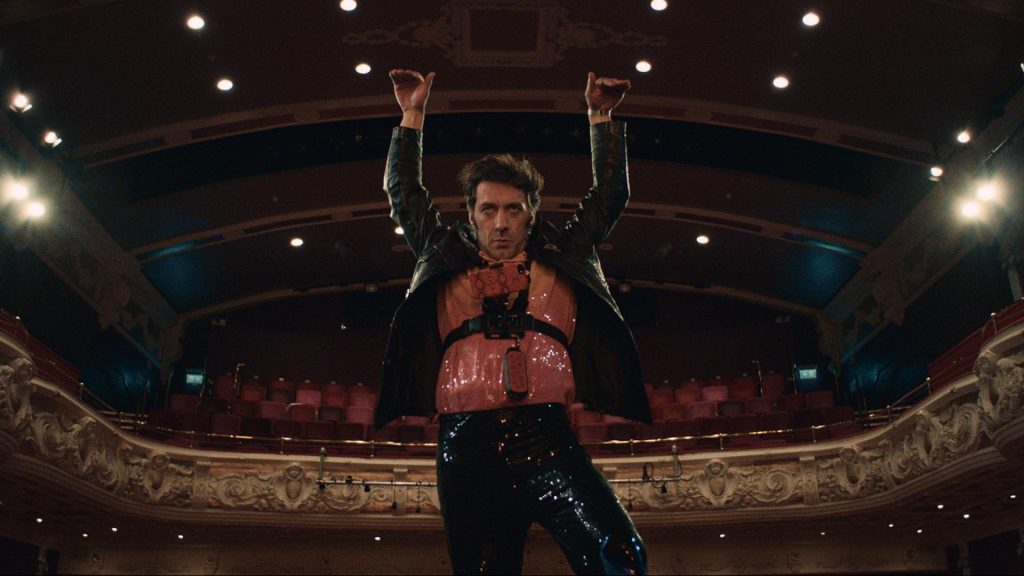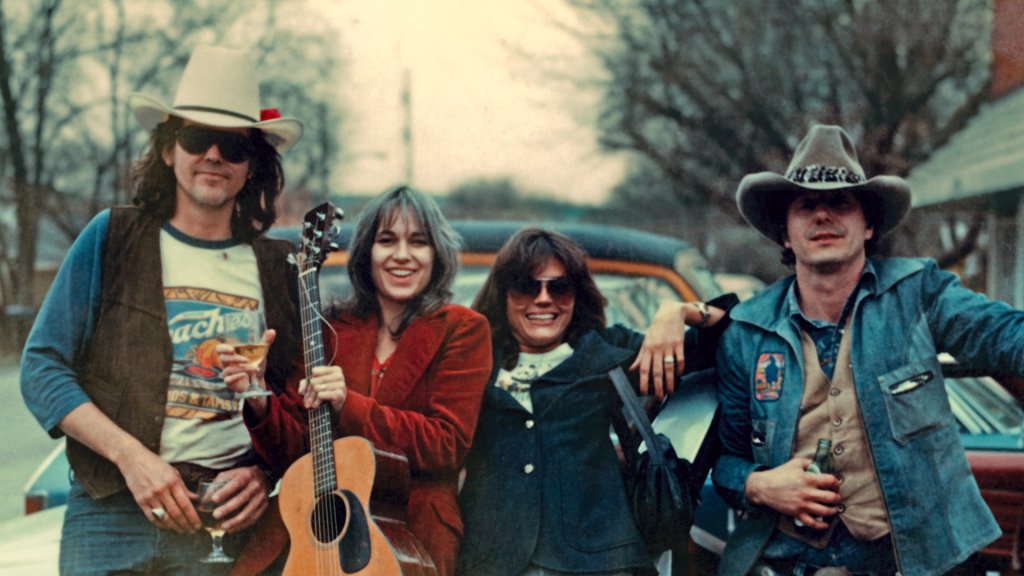March 21, 2021
by Carla Hay

Directed by Megan Park
Culture Representation: Taking place in an unnamed city in California’s Los Angeles County, the dramatic film “The Fallout” features a racially diverse cast of characters (Latino, white and African American) representing the middle-class.
Culture Clash: After experiencing a devastating school shooting, a teenage girl, her schoolmates and her family have different ways of coping with this tragedy.
Culture Audience: “The Fallout” will appeal primarily to people who are interested in well-acted and realistically written dramas about how a mass murder has psychological effects on survivors, particularly young people.
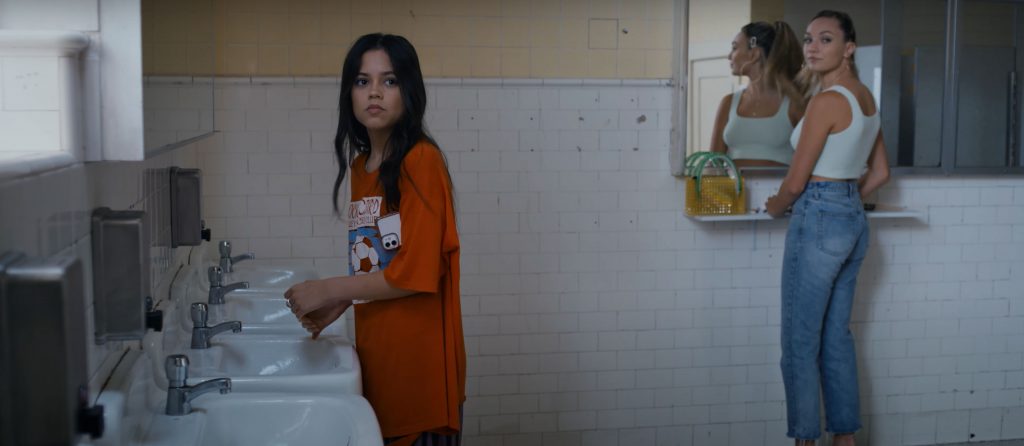
There have been several documentaries about how survivors of school shootings in the U.S. are coping with these tragedies. “The Fallout” is a fictional drama, but the movie achieves a rare balancing act of handling this sensitive subject matter with realistic emotions and above-average acting. What makes the movie also stand out is that it’s not a non-stop barrage of depression. It’s able to convey, with occasional touches of levity, how life can go on for survivors, even if their lives will no longer be the same.
Written and directed by Megan Park, “The Fallout” had its world premiere at the 2021 South by Southwest (SXSW) Film Festival, where it won the top jury prize as the best movie in the narrative feature competition. Writer/director Park, who made her feature-film directorial debut with “The Fallout,” also won the 2021 SXSW Film Festival’s Brightcove Illumination Award, given to a filmmaker on the rise. Park previously directed music videos, such as Billie Eilish’s “Watch.” Eilish’s brother/musical collaborator Finneas O’Connell wrote “The Fallout” musical score.
The beginning of “The Fallout” gives the appearance of being a typical teenage story. The movie’s protagonist Vada Cavell (played by Jenna Ortega, in a standout performance) and her openly gay best friend Nick Feinstein (played by Will Ropp) are driving in Nick’s car to their high school. They live in an unnamed city in California’s Los Angeles County. (The movie was filmed in Los Angeles.)
Vada (pronounced “vay-da”) and Nick appear to be 16 or 17 years old, probably in their third year of high school. If they were in their last year of high school, movies like this would make a point of telling the audiences that these students are high-school seniors because Vada and her classmates would be talking about their plans after they graduate. All of the main characters in the movie come from stable, middle-class homes.
Vada and Nick have the type of comfortable rapport that best friends have with each other, where they discuss things they wouldn’t talk about with just anyone. In their conversation while going to school, Nick and Vada talk about drinking coffee, which leads to Vada mentioning that coffee gives her the urge to defecate. Vada and Nick laugh and say that they should have a code for that bodily function when they talk about it in front of other people.
When Vada and Nick arrive at school, it seems like it’s going to be a normal day. The biggest problem that Vada thinks she’ll have to deal with that day is how to comfort her younger sister Amelia (played by Lumi Pollack), who has texted Vada a “911” emergency alert while Vada is in one of her classrooms. Vada quickly excuses herself from class to go in the hallway and call back Amelia, who attends another school and appears to be about 13 years old. Amelia is hiding by herself in one of her school’s restrooms.
It turns out that Amelia called because she’s surprised and embarrassed that she got her first menstrual period while in school, and she’s confused about how to handle it. Vada mildly scolds Amelia for scaring Vada into thinking it was a real emergency. Vada calms Amelia down and gives her a “big sister pep talk” on what do next. And like any good older sister would do, Vada offers to take Amelia out for a meal after school, so they can talk some more about this milestone in Amelia’s physical growth toward womanhood.
Feeling satisfied that she handled the situation correctly, Vada then goes into the ladies’ restroom. She sees a fellow classmate named Mia Reed (played by Maddie Ziegler) doing her own makeup in the restroom mirror. Based on the way that Vada stares at Mia, Vada is slightly in awe of Mia, who has the look of an Instagram model and a reputation at school for being somewhat of a social media influencer. The other students talk about Mia as if she’s a mysterious and glamorous loner, who gives the impression that she’s more sophisticated than the average student in high school.
Mia comments to Vada: “Photo day,” to explain why she’s doing her makeup instead of being in class. Vada replies before she goes into a stall, “I’ve got to get my shit together.” It’s Vada’s way of saying that she thinks she should pay more attention to her own hair, makeup and wardrobe. When Vada comes out of the stall, she says to Mia as a compliment, “You don’t even need to wear makeup.” And that’s when they both hear gunshots.
During the next six minutes of terror, which are shown from the point of view of the students trapped in this restroom, viewers can hear that people in the school are being killed by a gun. There are screams and cries for help amid the gunshots. This violence is never shown on camera because it doesn’t need to be. It’s a massacre that has occurred all too-often in real life.
Vada and Mia hide in the same bathroom stall together and stand up on the toilet, in case the shooter comes in and looks for feet underneath the stalls. As Mia and Vada clutch each other in horror, someone bursts into the room in the stall next to them. At first, the girls think it’s the shooter, but it’s really a fellow classmate named Quinton Hasland (played by Niles Fitch), who quickly identifies himself.
Mia and Vada tell Quinton that he can hide with them in the same stall. The girls are shocked to see that Quinton’s clothes are covered in blood spatter. He tells them that he hasn’t been shot, but he’s panicking because he witnessed his brother getting shot. Quinton is understandably anguished over the decision to run for his life or stay behind to try to help his brother.
The movie doesn’t show how long Vada, Mia and Quinton were crouched in fear in the bathroom stall. Nor does “The Fallout” show what happened when the police and medical emergency teams arrived. A visual clue later in the movie indicates that eight people died in this massacre.
And “The Fallout” isn’t about what happened to the shooter and why he committed this heinous crime, except to indicate that he was a male student from the school. The shooter is never seen or heard in the movie, although his name is mentioned in one of the movie’s most emotionally powerful scenes. It’s implied that the shooter died at the scene, most likely by a self-inflicted gunshot wound.
The rest of the film is from Vada’s perspective about how Vada, Mia, Quinton, Nick and Vada’s immediate family (her parents and Amelia) deal with the aftermath of tragedy, including coping with survivor’s guilt. Vada goes into school-appointed counseling with an empathetic therapist named Anna (played by Shailene Woodley), who tries to break down the emotional walls that Vada puts up in their first few sessions together. Vada tries to persuade Anna that she’s doing as well as she can in her recovery.
In her first session with Anna, Vada talks about how she sleeps up to 14 hours a day, but insists (not very convincingly) to Anna that it’s only a few more hours of sleep per day that was part of her normal routine before the shooting. Vada gives this self-evaluation of her personality: “I feel like I’m very good at managing my emotions. I’m very low-key and chill.” Anna patiently advises without sounding judgmental: “It’s really good to show your emotions.”
Despite what Vada told Anna, there are signs that Vada isn’t coping well at all. When Vada is awake in bed, she shivers and twitches in fear. Her excessive sleeping is a sign of depression. And when her parents—Carlos (played by John Ortiz) and Patricia (played by Julie Bowen)—try to talk to Vada about what happened, she shuts them down and tells them that she’s going to be fine. Vada avoids her family by sleeping in her room as much as she can.
During family time together, such as during meals, Amelia talks as if nothing bad really happened, perhaps in a way to try to get things back to normal. But based on Vada’s angry reactions to Amelia’s nonchalant small talk, Vada is offended that Amelia acts oblivious to how this tragedy is affecting Vada. Although Vada doesn’t want to open up to her family about what she’s going through, she doesn’t want them to completely act as if the school shooting didn’t happen either.
Shortly after the massacre, Vada found out that the shooter (whom she didn’t know) had followed Vada on Instagram. It’s a small detail, but how Vada reacts when she finds out is indicative of how she doesn’t like to show many of her emotions on the surface. She expresses some surprise, but then is quick to add that she never knew the guy and never followed him on social media. Her response is to brush it off, but deep down, this information must be disturbing to her.
After the shooting, Mia and Vada begin texting each other and become each other’s confidants. Mia invites Vada over to her house (it’s here that it’s obvious that Mia’s family has more money than Vada’s family), and this invitation leads to Vada going to Mia’s place for regular visits. Both girls are afraid to go back to school, but Mia’s anxiety is more severe, since she tells Vada that she’s afraid to leave her bedroom. Because of Vada’s visits, Mia gets over that fear and the fear of leaving her house.
Mia’s gay fathers, who are successful artists, are away in Japan on business. Mia, who is an only child, keeps in touch with them by phone, but they are never shown in the house with Mia. It’s implied that they leave Mia alone a lot, which is why she’s more independent than most of her teenage peers. But it’s also made her lonely, and it explains why she quickly bonds with Vada. After the school shooting, Mia’s parents grant Mia’s request to not go back to the school and to be homeschooled instead.
Vada is intrigued by Mia because before they became friends, she had a perception of Mia of being somewhat of a “badass,” based on Mia’s dance videos that Vada watches on the Internet. The first time that Mia and Vada hang out together, Vada remarks that in real life, Mia is very different than what Vada expected: “In the videos, you come off as so hard.” Vada is pleasantly surprised at how nice and down-to-earth Mia is when interacting with her. When Vada expresses anxiety about going to the funeral of Quinton’s brother, Mia offers to go to the funeral with Vada.
Because of what they went through together during the school shooting, Mia and Vada feel like they can openly talk to each other about it. During one such conversation, it’s revealed that while Vada’s way of dealing with the trauma is excessive sleeping, Mia’s anxiety has resulted in insomnia. Vada asks Mia, “Did you have the craziest nightmares last night?” Mia replies, “You have to be able to sleep to have nightmares.”
Mia is seemingly more confident than Vada, but Mia has her insecurities too. Mia guzzles wine and liquor and she smokes marijuana to block out whatever emotional pain she’s experiencing. Vada gets caught up in drinking alcohol and smoking weed with Mia.
And there’s a memorable scene in the movie where Vada impulsively tries Ecstasy for the first time when she’s at school. While flying high on Ecstasy, she gets blue ink from a pen all over her face, and she has trouble navigating her way down a flight of stairs. It’s one of the few scenes in “The Fallout” that’s intended to be funny. “The Fallout” infuses this slapstick comedy into the story as a way to show that life after a school shooting isn’t all gloom and doom for the survivors.
However, the movie also authentically shows in a non-judgmental way that drug use is often a coping mechanism for trauma survivors. Not much is shown or discussed about what Mia’s drug/alcohol use was like before the school shooting. But there are definite references to Vada being a good student before the shooting. Her “good girl” image begins to tarnish after the shooting took place when her grades start to slip, and she shows signs of minor delinquency.
Despite her occasional acts of teenage rebellion, there are signs that Vada identifies more with nerd culture. Vada mentions in a therapy session with Anna is that she has a celebrity crush on actor Paul Dano, who usually plays soft-spoken, geeky characters. And in a conversation between Vada and Mia, they ask each other if they prefer Drake as a sex-symbol rapper or when he portrayed a basketball-star-turned-misfit-paraplegic teen in the TV series “Degrassi: The Next Generation.” Mia and Vada both agree they prefer the wheelchair “Degrassi” version of Drake.
Vada’s parents try to do the best that they can to help her cope with the shooting tragedy, but Vada tends to avoid them. Vada’s relationship with her mother Patricia has more tension (Vada describes Patricia as “uptight”) than the relationship that Vada has with her father Carlos. There are also hints that some of this tension is because Vada thinks that Patricia prefers Amelia over Vada.
There’s a scene in the movie that exemplifies this tension. Vada sees Patricia and Amelia joking around together in the kitchen. Amelia and Patricia don’t see Vada though. Vada looks sad and a little jealous as she observes them and then walks away.
And in an earlier scene, Patricia tells Vada: “All I want is what’s best for you. I want to see that sparkle back.” Vada looks insulted by that comment, and then tells Patricia, as a way to hurt her mother emotionally: “You know that Amelia got her period?” Patricia looks surprised and says, “When?” Vada than smugly replies, “Like forever ago. I guess she just didn’t want you to know.”
But Vada is keeping secrets too. She doesn’t tell her family about her friendship with Mia. And as Vada spends more time with Mia, they become closer in a way that indicates that their relationship will become more than a friendship. Vada also expresses a sexual attraction to Quinton. (This isn’t spoiler information because it’s in the movie’s trailer.)
Vada doesn’t define her sexuality in this movie, but at one point in the story, she describes herself as a socially awkward virgin, and she expresses some disdain at the thought of herself having a husband in the future. It’s interesting that the two people who are her possible love interests are also the ones who were hiding with her in the restroom during the school shooting. The movie leaves it open to interpretation if Vada showing a romantic attraction to them after the shooting was a direct result of this shared trauma or if she was already attracted to them anyway.
Meanwhile, Kevin and Vada start to become distant from each other. He’s aware that Vada is spending more time with Mia. But he’s become an anti-gun-violence activist (there are scenes of Kevin doing things that will remind people of the real-life David Hogg), while Vada avoids going to the activist rallies that Kevin now enthusiastically attends. Vada admits to Mia that she feels a little guilty over not doing more to speak out against gun violence. But the movie shows that, just like in real life, not every survivor of a gun shooting is going to become an activist.
Before Vada’s life was turned upside down, she was closest to Kevin, her sister Amelia, her father Carlos and her mother Patricia. After the shooting, the movie shows an emotionally resonant moment that Vada has with each of them, as she comes to terms with how she’s changed since the tragedy and how her relationship with each of them has changed. When Vada has a heart-to-heart talk with her father, she says something that rings true to anyone who’s survived a mass shooting: “I had no idea one guy with a gun could fuck up my life so hard in six minutes.”
What will stick with people who watch “The Fallout” is how the main characters in the story seem like they could be based on real people, thanks to writer/director Park’s terrific handling of this story and the superb acting by the cast members. It’s not an easy thing to do a coming-of-age drama about people affected by a school massacre. And the last five minutes of “The Fallout” is a harrowing example about how “getting back to normal” is something that’s hard to define and even harder to experience.
UPDATE: HBO Max will premiere “The Fallout” on January 27, 2022. Warner Bros. Pictures will release “The Fallout” in cinemas in countries where HBO Max is not available.




